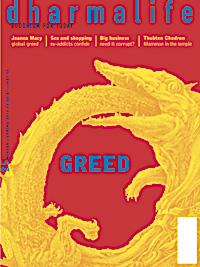Essentials of Mahamudra
Looking Directly at the Mind
Author:Khenchen Thrangu Rinpoche
Wisdom 2004, $16.95 £12.95 p/b
In Vajrayana Buddhism Mahamudra represents the culmination and fulfilment of all other practices. Maha means 'great' or 'vast' and mudra means 'seal' or 'symbol'. In the same way as Dharma means both Reality and the body of teachings that enable us to realise that reality, so Mahamudra refers to the nature of the ultimate (the 'seal' for all phenomena) and also a body of instructions for realising it. Khenchen Thrangu Rinpoche's Essentials of Mahamudra emphasises the latter, as his book is a practical guide containing clear instructions about practising Mahamudra meditation and, equally important, he says, how to sustain the practice 'post-meditation'.
As indicated by the book's subtitle, the distinctive feature of Mahamudra is that the mind itself is taken as the meditator's 'object'. The traditions of Nagarjuna's Middle Way (sunyata or emptiness) and Asanga's Mind Only philosophy come together in actual experience through the realisation of the Mind's emptiness and luminosity. Clear explanations of the meanings of these terms are given in the book. Thrangu Rinpoche emphasises that the practice is natural and straightforward: 'We are simply recognising mind's luminous emptiness, which is already there.'
At the same time, Rinpoche makes it clear that this naturalness and simplicity is only achieved with considerable application and effort. 'There is a big difference between relaxing within mind as it is and relaxing within ignorance.' The meditator has to learn how to concentrate the mind, and how to bring an analytical mind to bear on the constituents of existence. In this respect Part I of the book, 'Meditation Shared by Other Traditions' gives useful and systematic instruction in shamatha (concentration) and vipashyana (insight).
In Part II on 'Mahamudra Meditation' the first chapters cover the preparatory practices (common to all Tibetan Buddhist schools) and further advice on concentration, so that it is not until almost half way through the book that we get to a useful discussion of a distinctive feature of Mahamudra itself, 'Meditation without a Reference Point'.
The book is based on teachings given in California by way of exposition and commentary on a 16th-century Tibetan text called Moonlight of Mahamudra by Tashi Namgyal. The original text is not included, so that it is often impossible to tell whether we are reading an exposition of this text or Thrangu Rinpoche's commentary. However, the book is readable and clear, and accessible for a western audience.
Mahamati is the UK Convenor of men members of the Western Buddhist Order



